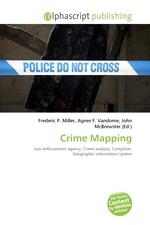Crime Mapping
Frederic P. Miller, Agnes F. Vandome, John McBrewster
бумажная книга
High Quality Content by WIKIPEDIA articles! Crime mapping is used by analysts in law enforcement agencies to map, visualize, and analyze crime incident patterns. It is a key component of crime analysis and the CompStat policing strategy. Mapping crime, using Geographic Information Systems, allows crime analysts to identify crime hot spots, along with other trends and patterns. Using GIS, crime analysts can overlay other datasets such as census demographics, locations of pawn shops, schools, etc., to better understand the underlying causes of crime and help law enforcement administrators to devise strategies to deal with the problem. GIS is also useful for law enforcement operations, such as allocating police officers and dispatching to emergencies. Underlying theories that help explain spatial behavior of criminals include environmental criminology, which was devised in the 1980s by Patricia and Paul Brantingham, routine activity theory, developed by Lawrence Cohen and Marcus Felson and originally published in 1979, and rational choice theory, developed by Ronald V. Clarke and Derek Cornish, originally published in 1986.
Данное издание не является оригинальным. Книга печатается по технологии принт-он-деманд после получения заказа.


